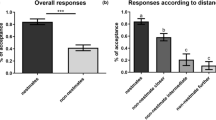Abstract
THE picture of a tiny passerine host feeding a huge cuckoo nestling challenges evolutionary biologists who explain animal behaviour as adaptive1–4. Cuckoo eggs sometimes resemble the eggs of the host, but nestlings of the common cuckoo, Cuculus canorus, look very different from the young of the host. The inability of the host to discriminate against such divergent nestlings is especially puzzling as some cuckoo hosts show a finely tuned discrimination ability between eggs5–8. Here I present a simple model to explain this paradox. The model shows that although learning to recognize eggs is adaptive, learning to recognize nestlings might not be. The mechanism of learned recognition, previously shown to maintain egg recognition, is unlikely to be adaptive for hosts like those of the common cuckoo, in which only the parasitic nestling remains in the nest. The reason that discrimination against parasite nest-lings is not adaptive is that the cost of misimprinting (learning to recognize the parasite nestling as the parents' own) exceeds the benefit of correct learning. The model also explains why nestling discrimination is mostly found in host–parasite systems in which the parasite and the hosts' young are reared together1.
Similar content being viewed by others
References
Davies, N. B. & Brooks, M. de L. Anim. Behav. 36, 262–284 (1988).
Davies, N. B. & Brooke, M. de L. J. Anim. Ecol. 58, 225–236 (1989).
Dawkins, R. & Krebs, J. R. Proc. R. Soc. Lond. B205, 489,–511 (1979).
Rothstein, S. I. Am. Zool. 22, 547–560 (1982).
Brooke, M. de L. & Davies, N. B. Nature 335, 630–632 (1988).
Davies, N. B. & Brooke, M. de L. J. Anim. Ecol. 58, 207–224 (1989).
Lotem, A., Nakamura, H. & Zahavi, A. Behavl Ecol. 3, 128–132 (1992).
Moksnes, A. et al. Behaviour 116, 64–89 (1990).
Rothstein, S. I. A. Rev. ecol. Syst. 21, 481–508 (1990).
Soler, M. & Møller, A. P. Nature 343, 748–750 (1990).
Rothstein, S. I. Auk 91, 796–807 (1974).
Rothstein, S. I. Anim. Behav. 26, 671–677 (1978).
Victoria, J. K. Ibis 114, 367–376 (1972).
Cramp, S. (ed.) The Birds of the Western Palaearctic Vol. 4 (Oxford University Press. Oxford, 1985).
Wyllie, I. The Cuckoo (Batsford, London, 1981).
Klomp, H. Ardea 58, 1–124 (1970).
Perrins, C. M. & Birkhead, T. R. Avian Ecol. (Blackie, Glasgow, 1983).
Payne, R. B. A. Rev. ecol. Syst. 8, 1–28 (1977).
Payne, R. B. Ecology 58, 500–513 (1977).
Lack, D. The Life of the Robin (Witherby, London, 1946).
Tinbergen, N. The Study of Instinct (Oxford University Press, London, 1951).
Author information
Authors and Affiliations
Rights and permissions
About this article
Cite this article
Lotem, A. Learning to recognize nestlings is maladaptive for cuckoo Cuculus canorus hosts. Nature 362, 743–745 (1993). https://doi.org/10.1038/362743a0
Received:
Accepted:
Issue Date:
DOI: https://doi.org/10.1038/362743a0
- Springer Nature Limited
This article is cited by
-
Fledgling discrimination in the hoopoe, a potential host species of the great spotted cuckoo
Behavioral Ecology and Sociobiology (2023)
-
Nestling discrimination and feeding habits during brooding of Chestnut Thrushes
Avian Research (2020)
-
How to Design Experiments in Animal Behaviour
Resonance (2020)
-
Egg-recognition abilities in non-incubating males: implications for the evolution of anti-parasitic host defenses
Behavioral Ecology and Sociobiology (2019)
-
Russet Sparrows spot alien chicks from their nests
Avian Research (2018)





